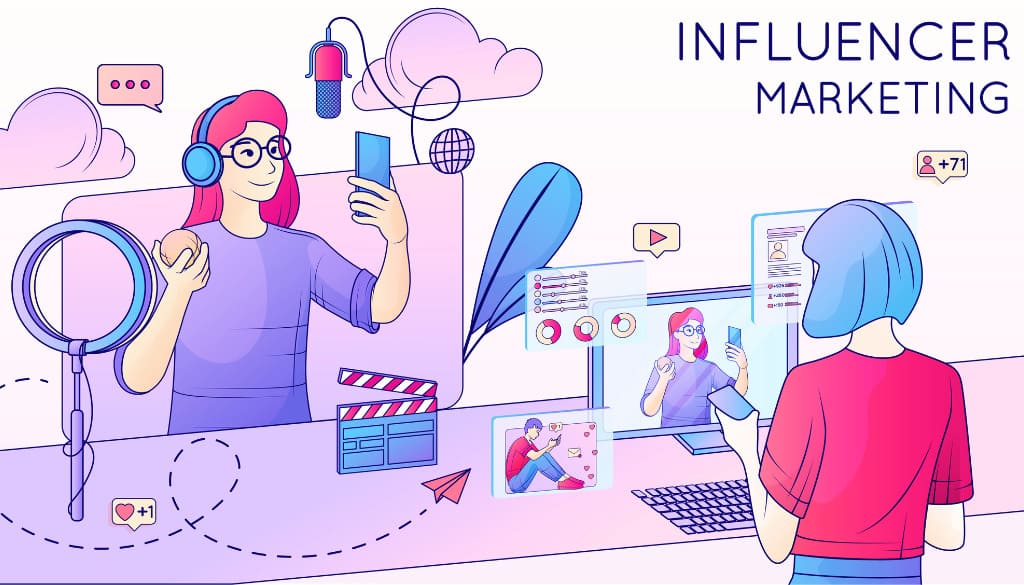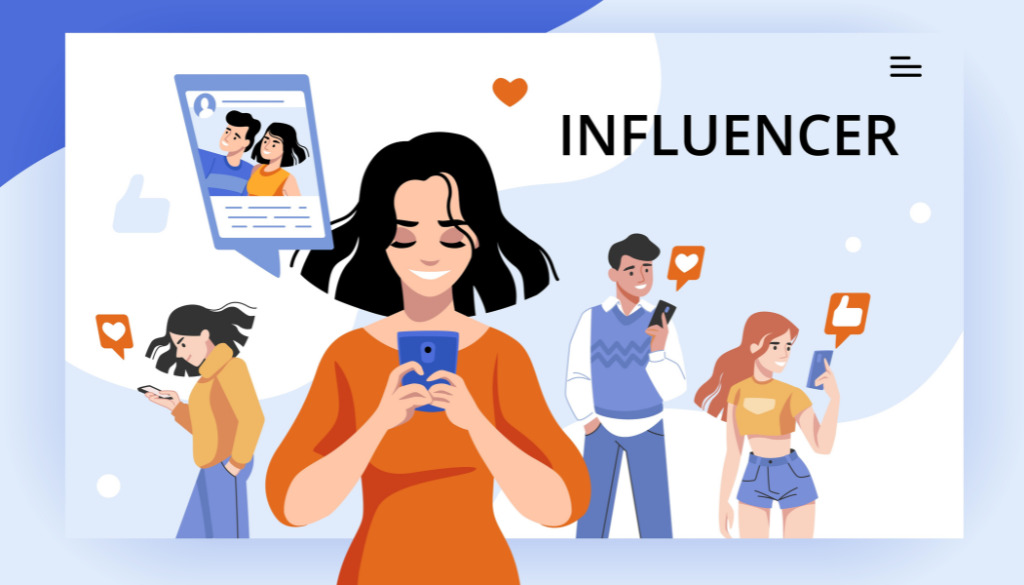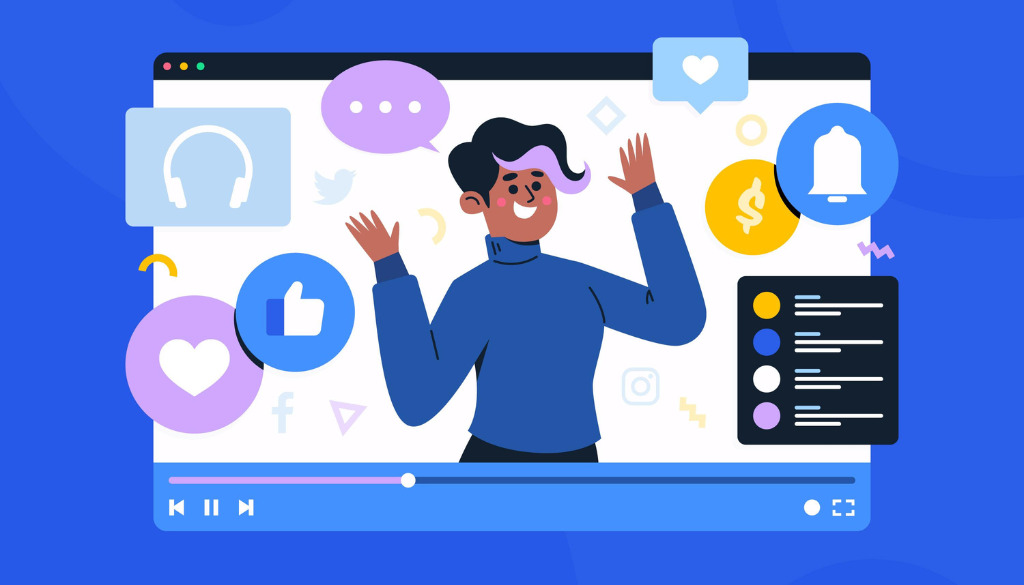Trong kỷ nguyên số, Influencer Marketing đã trở thành một trong những chiến lược tiếp thị hiệu quả nhất, đặc biệt với lĩnh vực Print on Demand (POD). Việc hợp tác với những người có tầm ảnh hưởng giúp seller tiếp cận khách hàng mục tiêu chính xác hơn, đồng thời xây dựng niềm tin và tăng khả năng chuyển đổi mua hàng. Trong bối cảnh cạnh tranh ngày càng khốc liệt, Influencer Marketing không chỉ mang đến đơn hàng bùng nổ, mà còn là chìa khóa để phát triển thương hiệu bền vững. Bài viết này sẽ giúp bạn hiểu rõ Influencer Marketing là gì, lợi ích và cách triển khai hiệu quả để bứt phá doanh thu POD.
Influencer Marketing là gì?

Trong thời đại số, người tiêu dùng ngày càng tin tưởng vào đánh giá từ cá nhân hơn là quảng cáo truyền thống. Điều này đã đưa Influencer Marketing trở thành một trong những chiến lược marketing hiệu quả nhất hiện nay.
Influencer Marketing là hình thức doanh nghiệp hợp tác với người có tầm ảnh hưởng (Influencer) để quảng bá sản phẩm hoặc thương hiệu đến một nhóm khách hàng mục tiêu. Những Influencer này có thể là KOLs (Key Opinion Leaders), Content Creator, hoặc micro-influencer, với khả năng tác động đến hành vi mua hàng nhờ uy tín và sức ảnh hưởng của họ trên mạng xã hội.
Với mô hình Print on Demand (POD) – nơi seller kinh doanh các sản phẩm in theo yêu cầu như áo thun, hoodie, cốc, poster… Influencer Marketing là công cụ đặc biệt hữu ích vì:
- Sản phẩm POD thường mang tính cá nhân hóa, dễ tạo sự đồng cảm với cộng đồng.
- Các nền tảng như TikTok, Instagram, YouTube là nơi mà khách hàng tiềm năng thường xuyên khám phá ý tưởng quà tặng và thời trang.
- Influencer giúp lan tỏa sản phẩm nhanh, tạo hiệu ứng viral và thúc đẩy doanh số bùng nổ.
Ví dụ: Một Influencer về thời trang phối đồ với áo hoodie thiết kế độc quyền của bạn và chia sẻ link mua trực tiếp → lượng truy cập và đơn hàng tăng mạnh chỉ trong vài ngày.
Các loại Influencer phù hợp cho POD
Không phải Influencer nào cũng phù hợp với sản phẩm POD của bạn. Việc lựa chọn đúng người có ảnh hưởng sẽ quyết định đến 80% thành công của chiến dịch. Dưới đây là các nhóm Influencer chính và cách họ có thể giúp bạn quảng bá sản phẩm POD:

1. Phân loại theo lượng người theo dõi
- Mega Influencer (Trên 1 triệu follower): Thường là những người nổi tiếng, ngôi sao, nghệ sĩ. Họ có khả năng tạo ra độ phủ thương hiệu cực lớn trong thời gian ngắn. Tuy nhiên, chi phí hợp tác rất cao và mức độ tương tác đôi khi không sâu bằng các nhóm khác.
- Phù hợp cho: Các thương hiệu POD lớn, muốn xây dựng nhận diện thương hiệu rộng khắp, chạy các chiến dịch lớn.
- Macro Influencer (100.000 – 1 triệu follower): Là các chuyên gia trong một lĩnh vực cụ thể, Vlogger, streamer nổi tiếng. Họ có sự cân bằng tốt giữa độ phủ và mức độ tương tác.
- Phù hợp cho: Các chiến dịch ra mắt sản phẩm mới, muốn tiếp cận một cộng đồng lớn nhưng vẫn có sự liên quan nhất định.
- Micro Influencer (10.000 – 100.000 follower): Đây là nhóm Influencer tiềm năng nhất cho phần lớn các seller POD. Họ thường là những người có chuyên môn sâu trong một thị trường ngách (niche), có mối quan hệ gần gũi và tương tác rất cao với người theo dõi. Lời khuyên của họ được xem là chân thực và đáng tin cậy.
- Phù hợp cho: Hầu hết các cửa hàng POD, đặc biệt là các niche như gaming, thú cưng, sách, phim ảnh, thể thao…
- Nano Influencer (1.000 – 10.000 follower): Là những người tiêu dùng có sức ảnh hưởng trong một cộng đồng nhỏ. Dù lượng follower không lớn, nhưng tỷ lệ tương tác và mức độ tin tưởng của họ là cao nhất. Chi phí hợp tác với họ cũng rất phải chăng, thậm chí có thể chỉ là tặng sản phẩm.
- Phù hợp cho: Các seller mới bắt đầu, ngân sách hạn hẹp, muốn xây dựng hiệu ứng “truyền miệng” và thu thập các đánh giá chân thực.
2. Phân loại theo lĩnh vực/nội dung
Đây là yếu tố quan trọng nhất đối với ngành POD. Bạn cần tìm những Influencer có nội dung và tệp người theo dõi trùng khớp với niche sản phẩm của mình.
- Fashion Blogger/Vlogger: Lựa chọn hoàn hảo cho các sản phẩm thời trang POD như áo thun, hoodie, mũ… Họ có khả năng phối đồ (mix & match) sáng tạo, giúp sản phẩm của bạn trở nên thời thượng và hấp dẫn hơn.
- Gamer/Streamer: Nếu bạn bán các sản phẩm có thiết kế liên quan đến game, đây chính là “mỏ vàng”. Một chiếc áo in hình nhân vật game yêu thích, một chiếc lót chuột độc đáo được streamer sử dụng trong buổi livestream có thể “cháy hàng” ngay lập tức.
- Bookstagrammer/Booktuber (Người review sách): Rất phù hợp để quảng bá tote bag, bookmark, cốc sứ… có in những câu trích dẫn hay, hình ảnh liên quan đến sách.
- Pet Influencer (Các kênh về thú cưng): Cộng đồng yêu thú cưng rất lớn và trung thành. Các sản phẩm như áo cho thú cưng, bát ăn, tranh vẽ… theo yêu cầu sẽ dễ dàng được đón nhận qua các kênh này.
- Artist/Designer: Họ có thể trực tiếp tham gia vào quá trình thiết kế hoặc đơn giản là sử dụng các sản phẩm decor nhà cửa như tranh canvas, poster, gối in… để trang trí không gian sống/làm việc của mình.
Lợi ích của Influencer Marketing đối với kinh doanh POD

Áp dụng Influencer Marketing một cách chiến lược có thể mang lại những lợi ích vượt xa cả con số doanh thu thuần túy.
- Tăng mức độ nhận diện thương hiệu (Brand Awareness): Sản phẩm của bạn sẽ ngay lập tức được hàng ngàn, thậm chí hàng triệu người biết đến chỉ qua một bài post, một video. Đây là cách nhanh chóng để đưa thương hiệu “vô danh” của bạn xuất hiện trên bản đồ thị trường.
- Xây dựng niềm tin và sự tín nhiệm (Build Trust & Credibility): Như đã nói, khách hàng tin tưởng Influencer. Khi một Influencer giới thiệu sản phẩm của bạn, họ đang gián tiếp “bảo chứng” cho chất lượng và uy tín của thương hiệu. Niềm tin này khó có thể xây dựng được qua các hình thức quảng cáo trả phí thông thường.
- Tiếp cận đúng đối tượng khách hàng mục tiêu: Influencer đã giúp bạn thực hiện công việc khó khăn nhất: tập hợp một cộng đồng những người có cùng sở thích, mối quan tâm. Bằng cách hợp tác với họ, bạn đang “đi đường tắt” để tiếp cận chính xác những khách hàng tiềm năng nhất cho sản phẩm POD của mình.
- Tăng tỷ lệ chuyển đổi và thúc đẩy doanh số: Một lời kêu gọi hành động (Call-to-Action) từ Influencer, kèm theo một mã giảm giá độc quyền, là công thức hoàn hảo để biến người xem thành người mua hàng. Các chiến dịch này thường tạo ra cảm giác cấp bách và độc quyền, thúc đẩy doanh số tăng vọt trong thời gian ngắn.
- Tạo ra nội dung chất lượng do người dùng tạo (User-Generated Content – UGC): Những hình ảnh, video mà Influencer tạo ra với sản phẩm của bạn là nguồn tài nguyên marketing vô giá. Bạn có thể tái sử dụng những nội dung này trên website, fanpage, email marketing… để tăng tính xác thực và thuyết phục cho các chiến dịch sau này.
- Cải thiện SEO: Khi các Influencer nổi tiếng (đặc biệt là các blogger có website riêng) nhắc đến và đặt link trỏ về cửa hàng của bạn, nó sẽ tạo ra những “backlink” chất lượng, giúp cải thiện thứ hạng website của bạn trên các công cụ tìm kiếm như Google.
Cách triển khai chiến dịch Influencer Marketing cho POD
Một chiến dịch thành công đòi hỏi sự chuẩn bị kỹ lưỡng và thực thi bài bản. Dưới đây là quy trình 7 bước để bạn triển khai chiến dịch Influencer Marketing cho cửa hàng POD của mình.

Bước 1: Xác định mục tiêu chiến dịch
Bạn muốn đạt được điều gì từ chiến dịch này? Mục tiêu càng cụ thể, càng dễ đo lường.
- Ví dụ: Tăng 20% doanh số cho dòng sản phẩm áo thun chủ đề “mèo” trong vòng 1 tháng.
- Ví dụ: Thu thập 50 hình ảnh feedback chất lượng từ khách hàng (thông qua Influencer).
- Ví dụ: Tăng 5.000 lượt theo dõi cho trang Instagram của cửa hàng.
Bước 2: Phác thảo chân dung Influencer lý tưởng
Dựa trên niche sản phẩm và đối tượng khách hàng mục tiêu, hãy vẽ ra hình mẫu Influencer bạn muốn hợp tác:
- Họ hoạt động trên nền tảng nào (Instagram, TikTok, YouTube)?
- Phong cách của họ là gì (hài hước, chuyên nghiệp, nghệ thuật)?
- Tỷ lệ tương tác (like, comment, share) trung bình của họ là bao nhiêu?
- Nhân khẩu học của người theo dõi họ (độ tuổi, giới tính, vị trí địa lý) có phù hợp với khách hàng của bạn không?
Bước 3: Tìm kiếm và lựa chọn Influencer
Đây là bước tốn nhiều công sức nhất.
- Tìm kiếm thủ công: Sử dụng hashtag liên quan đến niche của bạn trên Instagram, TikTok. Ví dụ: #bookstagramvietnam, #meowstagram, #foodblogger.
- Sử dụng các nền tảng (Platform): Có nhiều công cụ và nền tảng giúp kết nối thương hiệu với Influencer như REVU, 7Saturday, Hiip…
- Phân tích kỹ lưỡng: Đừng chỉ nhìn vào số follower. Hãy kiểm tra tỷ lệ tương tác (Engagement Rate = (Likes + Comments) / Followers * 100%). Một tỷ lệ tương tác tốt thường trên 3%. Đọc các bình luận để xem cộng đồng của họ có thực sự gắn kết không. Cẩn thận với các tài khoản có follower “ảo”.
Bước 4: Tiếp cận và đàm phán
- Soạn thảo email/tin nhắn chuyên nghiệp: Giới thiệu ngắn gọn về thương hiệu của bạn, tại sao bạn nghĩ họ phù hợp, và ý tưởng hợp tác ban đầu.
- Thảo luận rõ ràng về quyền lợi và nghĩa vụ:
- Quyền lợi cho Influencer: Phí cố định (booking fee), hoa hồng trên mỗi đơn hàng (affiliate), hay chỉ tặng sản phẩm?
- Yêu cầu của bạn: Số lượng bài đăng/video, nền tảng đăng, thời gian đăng, các hashtag cần sử dụng, link sản phẩm cần chèn…
- Luôn có hợp đồng: Dù hợp tác lớn hay nhỏ, một bản hợp đồng rõ ràng sẽ bảo vệ quyền lợi cho cả hai bên.
Bước 5: Cung cấp thông tin và sản phẩm cho Influencer
- Gửi sản phẩm: Đảm bảo sản phẩm được đóng gói cẩn thận, đẹp mắt. Có thể kèm theo một lá thư tay cảm ơn để tạo ấn tượng tốt.
- Cung cấp bản tóm tắt (Brief): Gửi cho Influencer một tài liệu ngắn gọn nêu rõ thông điệp chính bạn muốn truyền tải, các điểm nổi bật của sản phẩm, thông tin về chương trình khuyến mãi (nếu có). Tuy nhiên, hãy cho họ không gian để sáng tạo theo phong cách riêng. Đừng quá gò bó, vì sự chân thực chính là chìa khóa.
Bước 6: Theo dõi và đo lường hiệu quả
- Sử dụng link tracking/mã giảm giá riêng: Cung cấp cho mỗi Influencer một UTM link hoặc một mã coupon riêng biệt. Đây là cách chính xác nhất để đo lường xem ai mang lại nhiều click và đơn hàng nhất.
- Theo dõi các chỉ số:
- Reach & Impression: Lượt tiếp cận và hiển thị.
- Engagement: Lượt thích, bình luận, chia sẻ, lưu.
- Click-Through Rate (CTR): Tỷ lệ nhấp vào link.
- Conversion Rate: Tỷ lệ chuyển đổi thành đơn hàng.
- Return on Investment (ROI): (Lợi nhuận – Chi phí) / Chi phí.
Bước 7: Duy trì mối quan hệ
Nếu một Influencer mang lại hiệu quả tốt, hãy nghĩ đến việc xây dựng mối quan hệ hợp tác lâu dài. Họ có thể trở thành đại sứ thương hiệu (Brand Ambassador), giúp bạn duy trì hình ảnh thương hiệu một cách nhất quán và bền vững.
Bên cạnh đó, bạn có thể tìm hiểu thêm về mô hình “in theo yêu cầu với tiếp thị liên kết“, nơi bạn không chỉ kinh doanh sản phẩm POD mà còn tận dụng mạng lưới affiliate để mở rộng tệp khách hàng, tăng doanh thu thụ động và giảm rủi ro về chi phí quảng cáo.
Các hình thức Influencer Marketing phổ biến cho POD

Sự đa dạng của các nền tảng mạng xã hội cho phép bạn triển khai nhiều hình thức hợp tác sáng tạo.
- Bài đăng được tài trợ (Sponsored Posts): Hình thức phổ biến nhất. Influencer sẽ đăng ảnh hoặc video sử dụng sản phẩm của bạn lên trang cá nhân, kèm theo caption giới thiệu và link mua hàng. Rất hiệu quả trên Instagram và Facebook.
- Unboxing & Review: Influencer quay video quá trình “đập hộp” và chia sẻ những cảm nhận đầu tiên, đánh giá chi tiết về chất liệu, hình in, kiểu dáng sản phẩm. Hình thức này cực kỳ hiệu quả trên YouTube và TikTok vì nó tạo cảm giác chân thực và đáng tin cậy.
- Giveaway (Tặng quà): Tổ chức một mini-game trên trang của Influencer, với phần thưởng là sản phẩm POD của bạn. Đây là cách tuyệt vời để tăng tương tác, thu hút follower mới cho cả bạn và Influencer một cách nhanh chóng.
- Affiliate Marketing (Tiếp thị liên kết): Bạn cung cấp cho Influencer một đường link hoặc mã giảm giá riêng. Với mỗi đơn hàng thành công đến từ link/mã đó, Influencer sẽ nhận được một khoản hoa hồng. Đây là hình thức “win-win”, vì bạn chỉ trả tiền khi có kết quả thực tế.
- Takeover (Tiếp quản tài khoản): Cho phép Influencer “tiếp quản” tài khoản Instagram (ví dụ qua Stories) của bạn trong một ngày để chia sẻ về cuộc sống của họ và cách họ sử dụng sản phẩm của bạn. Cách này giúp tạo ra nội dung mới mẻ và thu hút người theo dõi của Influencer ghé thăm trang của bạn.
- Co-creation (Đồng sáng tạo sản phẩm): Hợp tác với Influencer (đặc biệt là các artist, designer) để cùng tạo ra một bộ sưu tập độc quyền. Tên tuổi của họ gắn liền với sản phẩm sẽ đảm bảo một lượng fan trung thành sẵn sàng mua hàng.
Sai lầm thường gặp khi làm Influencer Marketing cho POD
Mặc dù tiềm năng, nhưng không ít chiến dịch Influencer Marketing thất bại do những sai lầm đáng tiếc.
- Sai lầm 1: Chỉ chọn Influencer dựa trên số Follower
- Hậu quả: Tiếp cận sai đối tượng, tỷ lệ tương tác thấp, chi phí cao nhưng không hiệu quả. Follower có thể là “ảo”.
- Cách khắc phục: Ưu tiên tỷ lệ tương tác (engagement rate) và sự phù hợp của tệp follower với sản phẩm của bạn. Một Micro Influencer với 15.000 follower trung thành trong niche còn giá trị hơn một Macro Influencer với 200.000 follower hời hợt.
- Sai lầm 2: Thiếu mục tiêu và KPIs rõ ràng
- Hậu quả: Không thể đo lường được chiến dịch thành công hay thất bại, không rút ra được kinh nghiệm cho lần sau.
- Cách khắc phục: Thiết lập mục tiêu cụ thể ngay từ đầu (doanh số, traffic, follower…) và các chỉ số đo lường (KPIs) tương ứng. Sử dụng link tracking và mã giảm giá riêng cho từng Influencer.
- Sai lầm 3: Quá kiểm soát nội dung của Influencer
- Hậu quả: Nội dung quảng cáo trở nên gượng gạo, thiếu tự nhiên, làm mất đi sự tin tưởng của người xem.
- Cách khắc phục: Cung cấp thông điệp chính và cho Influencer tự do sáng tạo. Chính sự độc đáo và phong cách cá nhân của họ mới là thứ thu hút khán giả. Hãy tin tưởng vào khả năng sáng tạo của người bạn đã chọn.
- Sai lầm 4: Chỉ hợp tác một lần rồi thôi
- Hậu quả: Bỏ lỡ cơ hội xây dựng mối quan hệ bền vững và biến Influencer thành người ủng hộ thương hiệu lâu dài. Khách hàng cần thời gian để “thấm” thông điệp.
- Cách khắc phục: Xem xét việc hợp tác theo chuỗi (series) hoặc dài hạn với những Influencer mang lại hiệu quả tốt. Việc lặp lại thông điệp một cách tự nhiên sẽ giúp tăng cường niềm tin và nhận diện thương hiệu.
- Sai lầm 5: Bỏ qua việc minh bạch thông tin tài trợ
- Hậu quả: Có thể làm giảm lòng tin của khán giả và vi phạm quy định của một số nền tảng.
- Cách khắc phục: Luôn khuyến khích Influencer minh bạch về việc bài đăng được tài trợ bằng cách sử dụng các hashtag như #ad, #sponsored, hoặc tính năng “Branded Content” của nền tảng. Sự minh bạch sẽ xây dựng lòng tin lâu dài.

Influencer Marketing không còn là một lựa chọn, mà đã trở thành một phần thiết yếu trong chiến lược marketing của các seller POD thông thái. Bằng cách tận dụng sức mạnh của sự tin tưởng và khả năng kết nối cộng đồng, bạn có thể đưa những thiết kế độc đáo của mình đến với đúng người, đúng thời điểm.
Con đường này đòi hỏi sự nghiên cứu, kiên nhẫn và một chiến lược bài bản. Hãy bắt đầu từ việc xác định mục tiêu, lựa chọn những Influencer thực sự “tâm đầu ý hợp” với thương hiệu, đo lường hiệu quả và xây dựng những mối quan hệ đối tác bền chặt.
FlashShip tin rằng, với hướng dẫn chi tiết này, bạn đã sẵn sàng để khai phá tiềm năng to lớn của Influencer Marketing, tạo ra những chiến dịch đột phá và đưa doanh thu POD của mình lên một tầm cao mới!
Mời bạn xem thêm:

